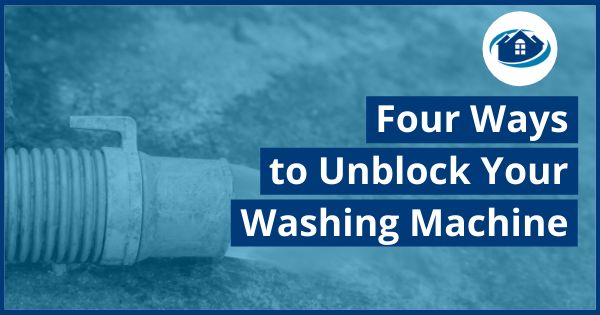Four Ways to Unblock Your Washing Machine

If you notice that your washing machine no longer drains water out, there is probably an issue with the pump, sump or filter. You can always rely on First Serve UK's expert help for any emergency repairs. However, if you want to attempt solving the problem yourself, here are a few simple tips.
Remember safety first! Unplug the power cable from behind the washing machine even if the socket is switched off. Do not attempt to open the washing machine without unplugging the power cable!
Secondly, remember to stay calm and follow the steps below. If you're ready to get your hands dirty - with a bit of hard work, you can fix the issue yourself.
#1 The Filter
Place a basin or a bowl under the washing machine. Where the filter is, you should see a flap at the bottom right side of the machine.
Open the flap and undo the filter by turning it to the left and pulling your filter out to see if anything is blocking it.
If the filter is blocked, you need to take it out and clean it with anything you can find, like long-nose pliers or a spoon or screwdriver and make sure you clear whatever is in there.
With the filter out, you might look at the pump because the filter is directly in front of it.
As there are seven different blocks in a washing machine repair, you may as well check the other likely blocks under the washing machine while you're at it.
#2 The Pump
The pump is located behind the filter, so it makes perfect sense to look there next.
With the filter housing empty, you should be able to stick your finger in till it reaches the pump propeller, then turn your propeller clockwise and anti-clockwise.
If it doesn't turn, or there's resistance, or it's very loose, the chances are that there's a string, elastic band or hairband wrapped around the propeller. Or the propeller is loose because it's broken.
Where you're sure there are no obstructions, you can go on to the next possible block, but if you're sure there's an obstruction that you can't get to, you must take the pump out so you can inspect it properly.
Put the filter back in and screw it up tight and take time to ensure it's not cross-threaded or it will leak.
Slowly lower the washing machine onto its 4 feet, pull the machine further out towards you, get something like an Argos catalogue and put it on the floor, placing your two hands at 12 o'clock and pulling towards you.
With the catalogue to your left, lower the washing machine down on top of it. Doing this will leave a space between the floor and the machine, which you're going to need when you have to lift the machine upright again.
Ensure the soapbox dispenser is near the floor, so any water inside the machine drains out onto the floor.
There's a wide-open space under the washing machine, large enough for you to work and get access to the pump.
Right where the flap for the filter is, you may find that there is one screw that holds the filter housing and filter in place to the machine. It could even be 2, 3, or 4 screws depending on the model.
Remove the screws, and the filter housing will pop out from its place. Attached to the filter housing will be the pump fastened by the screws: the sump hose, which is black and the drain hose, which is grey.
Please take a picture so that you'll have no problem when it comes to putting everything back together again.
Undo the three screws on the pump, and it will come apart from the housing. Now you can see if there are any obstructions in your pump, you can check if the propeller is loose or broken, also you can do a continuity test with a multimeter to see if the pump is faulty.
#3 The Sump Hose
The sump hose is the black hose that is attached to the filter housing on one end and the sump on the other end.
The hose is fixed onto the hose by a clamp clip. It would help if you had a pipe grip or wrench to squeeze the two ends together so the clip opens up so you can then take the hose off.
Now, use your grip to take the clamp fitting off the sump. The fitting can sometimes look like a large jubilee clip; use your screwdriver to undo and remove it from the sump.
Squeeze your pump, tap it on a hard surface, flush it out with full water pressure, shake it, push your fingers through it, make sure there's no baby sock, underwear, lint, tissue, trainer sole etc. and make sure that there's no bra wire in there.
#4 The Sump
The sump is a hole at the bottom of the washing machine.
It's where the wash water exits the drum, and sometimes a block could be right there. Whether a sock, underwear, a sole of a trainer shoe that's stuck, it could be anything!
So, there we have it – we've covered so far four of the seven things that can block your washing machine.
I hope you found these tips useful. We are interested if you have any tips of your own that you'd like to share.
Would you mind sharing these tips with your friends and family?
Need a repair?
If you need a repair or want to talk to us about your machine, please ring us on 07984 670782 or book an appointment via our online booking system.
If you have any questions, comments, or queries that come to mind, please get in touch with us at book@firstserveuk.co.uk or ring us on 0798 4670 782.

